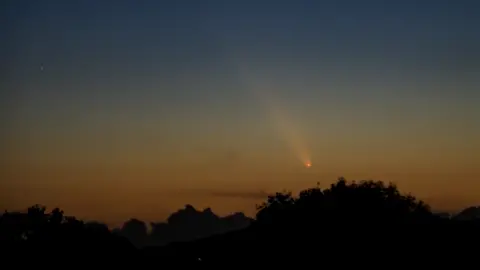Joy for photographer who saw 'comet of the century'
Caroline Gall
BBC News, West Midlands

The Royal Astronomical Society has called A3 (Tsuchinshan-ATLAS) the "comet of the century", because of how bright and visible it can be
A rare comet has been snapped hurtling through the night skies over part of the West Midlands.
Joanna, from the Black Country, shared an image of Comet A3 (Tsuchinshan-ATLAS) with BBC News, taken at Kinver, in Staffordshire on Saturday night.
The comet was visible for the first time in 80,000 years about two weeks ago, and astrologers said it might be possible to view with the naked eye on Saturday.
The Royal Astronomical Society (RAS) has called it the "comet of the century" because of how bright and visible it can be.
On Saturday, the comet was expected to come within about 70 million km (44 million miles) of Earth, according to the Nasa Earth Observatory.
In a post on X Joanna, who did not give the BBC her surname, said: "Well, I can’t feel my fingers, but it was worth it.
"There she is. Comet C/2023 A3 Tsuchinshan-Atlas. Hopefully this isn’t the only chance I’ll get to see her."
She said she took the photograph at about 19:40 BST after going out to see if she could see the comet.
It was first visible in the southern hemisphere between 27 September and 2 October and is visible until 30 October, the RAS said.
The nucleus of the comet - its solid core - has been estimated to be 2km (1.24 miles) in diameter.
Joanne said she had captured other phenomena in the night skies this year including a rocket launch, the northern lights and the milky way.
"What a year it’s been," she posted.
Stargazers capture 'comet of a lifetime' in UK skies after last being viewed by neanderthals 80,000 years ago
13 October 2024, 09:31 | Updated: 13 October 2024, 09:33

Brits turned their attention to the skies on Saturday night in the hopes of catching a "once in a lifetime" comet.
The celestial A3 comet was at peak brightness as it passed by Earth on Saturday night, visible for a matter of minutes before disappearing for another 80,000 years.
The space rock, described as the "comet of the century", originates from the Oort Cloud, a giant ring of rocks and ice around the solar system.
Read More:
Read More:
The comet, which has a full designation of Comet C/2023 A3, was previously able to be seen from Earth earlier this month.
The wonder, which was first discovered in January 2023, was visible with the naked eye and last viewed by neanderthals on Earth some 80,000 years ago.

According to the Nasa Earth Observatory, the comet came within about 70 million km (44 million miles) of Earth on Saturday.
Visible shooting across skies in Spain, Italy, Uruguay, and Indonesia, the comet was visible intermittently across the southern hemisphere between late September to early October.
After disappearing because it drifted too close to the sun, the comet reappeared on Saturday before vanishing for the remainder of our lifetimes.
Taking to social media, stargazers posted a host of jaw dropping shots of the comet from locations across the world.
X user Andrew McCarthy wrote: "Here’s a photo I’ll never be able to capture again… here’s comet c/2023 A3 in conjunction with the fully-stacked starship rocket, a serendipitous juxtaposition.
"In 8 hours, starship will make history as the booster returns to the landing site to be “caught” by the tower."
Another X user wrote: "What a sunrise!!! I took this pictures of the comet C2023 A3 and the partial solar eclipse from Maunakea Hawaii."
A third user posted a time-lapse of the comet, picturing the "rare pairing" of the comet and the moon an hour before sunrise on the Vieques island a week ago.

The comet is set to shine at around a magnitude +2 or magnitude +1, the measurement of the brightness of space objects.
It will make the comet as visible as Polaris, the north star.
After October 13, the comet dim and disappear completely around 20 October.
The comets trail of dust and ice will be illuminated in blue and white by the sun during its approach.
No comments:
Post a Comment